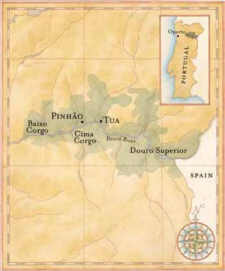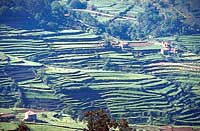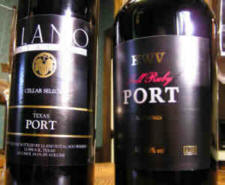|
Celebrating Port
|
|
By: Thomas M. Ciesla December 2005
|
|
One could say that Port is an enigma in the wine world; soothing yet celebratory, dry or fruity-sweet. Popularity of this famous sweet wine from Portugal is magnified during the holiday season, when as the days grow colder, the warming effects of Port make it a perfect companion as either an aperitif or a dessert wine.
|
 The Douro Valley: Birthplace of Port
|
Port is a fortified wine, named after the Portuguese coastal city of Oporto, located at the mouth of the Douro River. For centuries, winemakers have used this river to transport their wines to the 'lodges' in Oporto where the wine is classified and aged. True Port wine only comes from the terraced vineyards on the slopes of the Douro Valley, where for hundreds of years winegrowers have 'smashed' the rock into rubble in order to plant vineyards. In this arid, austere environment, the vines are forced to send roots 45-60 feet down into the ground in search of water, stressing the vines and concentrating the flavors and minerals into the grapes.
|
|
Today "port" style wines are produced in most of the world's wine regions, but none of these can match the nuances and complexity of Port produced in "the Douro" as this area is called. The conditions here exemplify the French concept of 'terroir', which includes soil, geographic location, weather, and wine growing practices.
|
 The terraced vineyards of the Douro Valley
|
What does a red dog, a cat's tail, a ewe's tail and a dog's strangler have in common? They are all names of Portuguese grape varieties. Portugal has remained a viticultural island until the last twenty years, with few of the classic vinifera varietals of France, Italy, and Spain making incursions into the country.
|
|
Portugal is home to an estimated 250-300 genuine grape varieties, many with origins in the Middle Ages or older. From this wide variety, Port may be made from only 80 approved grapes. Since the 1970s, however, attention has focused on five varieties: Tinta Barroca, Tinto Cao, Touriga Francisca, Touriga Nacional, and Tinta Roriz. Today, there is interest in a few other red grapes such as:Sousao, Tinta Amarela and Tinta da Bianca, primarily for color and sweetness.
|
|
Winemaking Process
Fermentation of the grapes for Port can be a short as 48 hours, leaving precious little time for the winemaker to extract the flavors and color he needs from the grape skins. Given this short skin contact time, vigorous maceration in a lagar (cement tank) -- whether using treading by foot, or modern robot treaders -- is essential. When the yeasts have turned about half of the grape's natural sugar into alcohol, the treading stops and a colorless brandy is added to the fermenting juices. This 'fortification' with brandy stops the fermentation, leaving most of the original sweetness in the wine, and raising the alcohol concentration to around 20%. As the wine matures, the brandy and the wine combine to give rise to that signature Port taste, exhibity a complex range of flavors.
|
 The dramatic color dfference between
a Vintage Port and a Tawny Port
|
In the Spring after harvest, the wine is shipped down river to the lodges in Oporto for classification and aging. At this point the wine is not Port, but a fortified wine needing the craftmanship of the expert tasters in the lodges. As a fortified wine, the nascent Port is capable of aging in wood for a much longer period than typical wine -- from 2 years to decades. Port may mature in a vat, cask, or bottle, or a combination of these -- which gives rise to the many different styles of Port.
|
|
Port can be divided into two categories: Vintage Ports and Wood Ports. Vintage Ports age briefly in wood and then spend years maturing in the bottle. Wood Ports are defines as everything other than Vintage Ports, including such recognizable wines such as Ruby, Tawny, Late Bottle Vintage, Crusted Port and Calheita Port.
Vintage Port is the rarest and finest of all ports, needing a minimum of 10-15 years of bottle aging before reaching maturity, though most can keep for 20 years or more. Ruby Ports are the youngest and fruitiest, being rich and peppery, and sometimes raw and spirity. While bottle aging does not improve this wine, it is stable and can last long after opening.
Tawny Ports derive their name from the mahagony color of the wine, the result of spending extended maturation time in wood (10,20,30 or 40 years), which imparts a silky complexity in flavors. Tawnies are blends, so the age on the bottle label is an average of the wines in the bottle. A 20-year old Tawny Port, for example, will contain wines older than 20 years, and wines younger than 20 years of age.
Another kind of Tawny is vintage dated Colheita Port. These are made from a single vintage, and age in wood for extended periods. They cannot be bottled before a minimum of seven years -- after that it's up to the winemaker to decide when to bottle. Colheita Port will show two dates on the label: the year of harvest and the year of bottling.
|
 A Tawny and A Late Bottle Vintage Port
from major producers in the 'Douro'
|
A third style of Wood Port is Late Bottles Vintage Port. It is a wine from a single vintage, but unlike Vintage Port, these wines are bottled after a minimum of four years and a maximum of six years in wood. LBV's retain their full-bodied ripeness and are drinkable when they reach the market.
The final style of Wood Ports is Crusted Port. This a blend of multiple vintages and is bottled unfiltered, developing sediment over the years like a Vintage Port.
|
|
Up to this point our discussion has focused on Ports made in Portugal, where every aspect of production is controlled by tradition and a tough set of standards. Some countries -- such as the EU nations and Canada -- have agreed that only wines from the Douro Valley can be labeled as "Port", but the U.S., Australia, and South Africa have not signed on to that agreement. Consequently, besides the official Port designation, there are a myriad of "Ports" being produced in the New World.
|
 New World 'Ports' from Llano Estacado Winery in Texas, and KWV Wines in South Africa
|
|
|
The classic port grapes of the Douro Valley are rarely found in New World wine regions. Instead, vinifera varieties that do well in these newer wine regions are enlisted. In the United States, "Ports" are made from Carignane, Grenache, Mission, Zinfandel and Petit Syrah. Some wineries have even produced a "port" from blackberries. Aging standards vary from producer to producer, so comparisons to Port from 'the Douro' are practically impossible.
Port's increasing popularity is compelling winemakers everywhere to enter this fast growing market. Currently in Texas, roughly 20% of the wineries produce at least one 'Port" and some are producing two or three styles. The Mission grape (a.k.a. Black Spanish or Lenoir grape) is the most popular choice among Texas winemakers, though Cabernet Sauvignon and Zinfandel have also been used.
|
 Port is a great wine with dessert
|
Port should be treated like any other fine wine. If you are 'laying-up' Vintage Port for aging, the bottle should be stored on the side with label up, at around 55-65 degrees Farenheit and 65% humidity. Vintage and Crusted Ports develop sediments requiring you to decant before serving.
Port is traditionally served at the end of a meal. It is meant to be sipped, alolwing its warming effects to stimulate great conversations. It pairs well with cheeses such as Stilton, Cheddar or Glouster as well as walnuts, chestnuts and cashews. For pairing with dessert, look to something with strawberries, raspberries or cherries.
|
|
Port & The Bishop
There are many myths and traditions surrounding the drinking of Port. Perhaps the most famous is the British naval custom of "port-to-port"
-- the host will pour a glass for the person seated at their right, and then pass the bottle or decanter to the left (clockwise); this practice is then repeated around the circle. If the port becomes stalled at some point, it is considered poor form to ask for the container directly. Instead, the person seeking a refill asks the person holding the bottle: "Do you know the bishop of Glouchester?" If he does not know the ritual and hence replies in the negative, the querent will remark, "He's an awfully nice fellow, but he never remembers to pass the port."
So the next time you are enjoying Port with friends, remember to share!
|
|

Whence Fortification?
Records show that merchants began adding brandy to the barrels of wine to stabilize them for the long voyage to England. No one knows for sure, however, when the process of adding brandy DURING fermentation began. Some stories attribute it to the monks in the Douro Valley.
|
"A pint of old Port
and a devilled biscut
can hurt no man"
|
|
|
|
 A Taylor Fladgate Port Tasting
in the Canadian Rockies
Port Pipes
At the lodges, the wines rest in large casks called "pipes" The Large volume of these containers reduces to amount of wine exposed to oxygen, creating a richer, smoother taste.
Texas Port Producers
Circle S Vineyards
Fredericksburg Winery
Haak VIneyards
Kiepersol Vineyards
La Buena Vida Vineyards
Lehm Berg Winery
Lightcatcher Winery
Llano Estacado Winery
Messina Hof Winery & Resort
Piney Woods Winery
Pleasant Hills Winery
Tehucana Creek Vineyards & Winery
Texas Hills Vineyard
Torre di Pietra
Wichita Falls Winery
Windy Hill Winery
Winery in Grand Prarie
Woodrose Winery & Resort
|
|
|
Pronunciation Guide:
Tinto
[teen-to]
Lagar
[la-GAR]
Touriga Nacional
[too-REE-gah na-SHUN-al]
Porto
[PORT-o]
Tinta Roriz
[teen-ta HOR-eez]
Colheita
[col-YATE-a]
Quinta
[KEEN-ta]
|
|